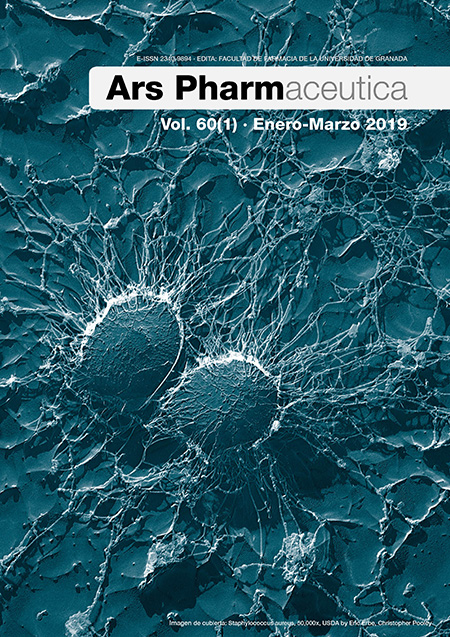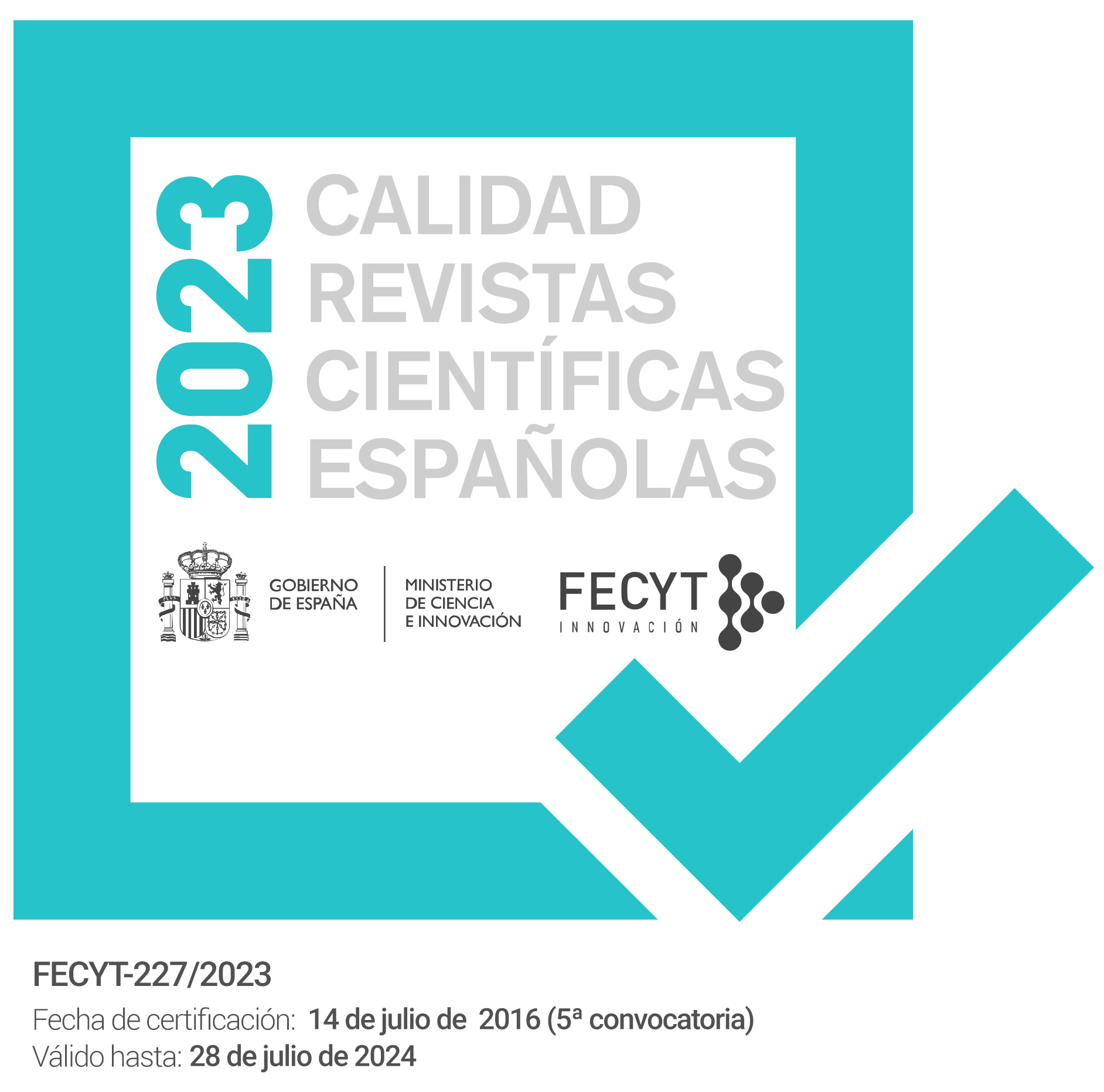Efecto inhibidor de Lactobacillus aislado de la cavidad oral contra patógenos bacterianos y su efecto en la promoción de la salud
DOI:
https://doi.org/10.30827/ars.v60i1.7943Palabras clave:
Lactobacillus, condición de salud, actividad antibacteriana, cavidad oralResumen
Objetivos: Determinar el efecto inhibidor del Lactobacillus aislado de la cavidad oral contra patógenos bacterianos e investigar la correlación entre la presencia de cepas de Lactobacillus y la promoción de la salud.
Método: se recolectaron cien muestras de saliva de la cavidad oral de consumidores de productos lácteos y se investigó el aislamiento e identificación de la cepa de Lactobacillus mediante cultivo convencional y secuenciación de 16SrRNA. Además, se realizó un ensayo de difusión en pocillos para determinar la actividad antibacteriana de las cepas de Lactobacillus contra patógenos bacterianos que incluyen Salmonella typhimurium, Klebsiella pneumoniae, Shigella sonnei, Shigella dysenteriae, Enterococcus faecalis y Enterococcus faecium. Finalmente, se investigó la asociación entre el estado de salud y el aislamiento de Lactobacillus y se obtuvieron los datos utilizando el cuestionario mediante la prueba de chi-cuadrado.
Resultados: Se aislaron treinta cepas de Lactobacillus de 100 muestras de saliva. La cepa aislada más común fue L. gasseri (n = 18), seguida por L. vaginalis (n = 3) y L. salivarius (n = 3). Todas las cepas de Lactobacillus demostraron actividad antibacteriana contra al menos uno de los patógenos investigados. Sin embargo, los resultados más fuertes fueron obtenidos por L. vaginalis contra K. pneumonia. No se encontraron correlación entre la presencia de algunas de las treinta cepas de Lactobacillus y la promoción de la salud. Sin embargo, solo la especie L. gasseri tuvo un impacto positivo significativo en la salud de sus hospedadores (P <0,05).
Conclusión: solo algunas especies de Lactobacillus tienen un impacto positivo en la promoción de la salud. A pesar de la actividad débil contra los patógenos investigados, L. gasseri tiene un impacto positivo en el problema mental (ira intensa y depresión) de sus huéspedes.
Descargas
Citas
Wannun P, Piwat S, Teanpaisan R. Purification and characterization of bacteriocin produced by oral Lactobacillus paracasei SD1. Anaerobe. 2014;27:17-21. Doi: 10.1016/j.anaerobe.2014.03.001
Sutula J, Coulthwaite L, Verran J. Culture media for differential isolation of Lactobacillus casei Shirota from oral samples. J microbiol methods. 2012;90(1):65-71. Doi: 10.1016/j.mimet.2012.03.015
Kumar A, Kumar D. Characterization of Lactobacillus isolated from dairy samples for probiotic properties. Anaerobe. 2015;33:117-123. Doi: 10.1016/j.anaerobe.2015.03.004
Davoodabadi A, Dallal MMS, Foroushani AR, Douraghi M, Harati FA. Antibacterial activity of Lactobacillus spp. isolated from the feces of healthy infants against enteropathogenic bacteria. Anaerobe. 2015;34:53-58. Doi: 10.1016/j.anaerobe.2015.04.014
Teanpaisan R, Piwat S, Dahlen G. Inhibitory effect of oral Lactobacillus against oral pathogens. Lett Appl Microbiol. 2011;53(4):452-459. Doi: 10.1111/j.1472-765X.2011.03132.x
Piwat S, Teanpaisan R, Thitasomakul S, Thearmontree A, Dahlen G. Lactobacillus species and genotypes associated with dental caries in Thai preschool children. MoleculOral Microbiol. 2010;25(2):157-164. Doi: 10.1111/j.2041-1014.2009.00556.x
Petricevic L, Domig KJ, Nierscher FJ, et al. Characterisation of the oral, vaginal and rectal Lactobacillus flora in healthy pregnant and postmenopausal women. Europ J Obst Gynecol Reprod Biol. 2012;160(1):93-99. Doi: 10.1016/j.ejogrb.2011.10.002
Jørgensen MR, Kragelund C, Jensen PØ, Keller MK, Twetman S. Probiotic Lactobacillus reuteri has antifungal effects on oral Candida species in vitro. J Oral Microbiol. 2017;9(1):1274582. Doi: 10.1080/20002297.2016.1274582
Azimi S, Kafil HS, Baghi HB, et al. Presence of exoY, exoS, exoU and exoT genes, antibiotic resistance and biofilm production among Pseudomonas aeruginosa isolates in Northwest Iran. GMS Hyg Infect Control. 2016;22(11).
Jalilpour Y, Abdollahzade B, ParviziFard G, Aghazadeh M, Bialvaei AZ, Kafil HS. A simple route for preparation of pH-sensitive hydrogels by using egg white proteins in Alginate scaffold for the encapsulation of probiotics. Ars Pharmaceut. 2017;58(3):1-10.
Dal Bello F, Hertel C. Oral cavity as natural reservoir for intestinal lactobacilli. System Appl Microbiol. 2006;29(1):69-76. Doi: 10.1016/j.syapm.2005.07.002
Gholizadeh P, Eslami H, Yousefi M, Asgharzadeh M, Aghazadeh M, Kafil HS. Role of oral microbiome on oral cancers, a review. Biomed Pharmacother. 2016;84:552-558. Doi: 10.1016/j.biopha.2016.09.082
Gholizadeh P, Eslami H, Kafil HS. Carcinogenesis mechanisms of Fusobacterium nucleatum. Biomed Pharmacother. 2017;89:918-925. Doi: 10.1016/j.biopha.2017.02.102
Rammelsberg M, Radler F. Antibacterial polypeptides of Lactobacillus species. J Appl Microbiol. 1990;69(2):177-184.
Pan Y, Wang F, Sun D-W, Li Q. Intestinal Lactobacillus community structure and its correlation with diet of Southern Chinese elderly subjects. J Microbiol. 2016;54(9):594-601. Doi: 10.1007/s12275-016-6131-7
Köhler B, Bratthall D. Practical method to facilitate estimation of Streptococcus mutans levels in saliva. J Clin Microbiol. 1979;9(5):584-588.
Jabbari V, Khiabani MS, Mokarram RR, et al. Lactobacillus plantarum as a Probiotic Potential from Kouzeh Cheese (Traditional Iranian Cheese) and Its Antimicrobial Activity. Probiotic Antimicrob Protein. 2017;9(2):189-193. Doi: 10.1007/s12602-017-9255-0
Kafil HS, Mobarez AM, Moghadam MF. Adhesion and virulence factor properties of Enterococci isolated from clinical samples in Iran. Indian J Pathol Microbiol. 2013;56(3):238. Doi: 10.4103/0377-4929.120375
Jabbari V, Mokarram RR, Khiabani MS, et al. Molecular Identification of Lactobacillus acidophilus as a probiotic potential from traditional doogh samples and evaluation of their antimicrobial activity against some pathogenic bacteria. Biomed Res. 2017;28(4):1458-1463.
Asgharzadeh M, Khakpour M, Salehi TZ, Kafil HS. Use of mycobacterial interspersed repetitive unit-variable-number tandem repeat typing to study Mycobacterium tuberculosis isolates from East Azarbaijan province of Iran. Pak J Biol Sci. 2007;10(21):3769-3777. Doi: 10.3923/pjbs.2007.3769.3777
Raei P, Pourlak T, Memar MY, et al. Thymol and carvacrol strongly inhibit biofilm formation and growth of carbapenemase-producing Gram negative bacilli. Cell Mol Biol. 2017;63(5):108-112. Doi: 10.14715/cmb/2017.63.5.20
Le Roy CI, Štšepetova J, Sepp E, Songisepp E, Claus SP, Mikelsaar M. New insights into the impact of Lactobacillus population on host-bacteria metabolic interplay. Oncotarget. 2015;6(31):30545. Doi: 10.18632/oncotarget.5906
Bosch M, Nart J, Audivert S, et al. Isolation and characterization of probiotic strains for improving oral health. Arch Oral Biol. 2012;57(5):539-549. Doi: 10.1016/j.archoralbio.2011.10.006
Štšepetova J, Sepp E, Kolk H, Loivukene K, Songisepp E, Mikelsaar M. Diversity and metabolic impact of intestinal Lactobacillus species in healthy adults and the elderly. British J nutr. 2011;105(8):1235-1244. Doi:10.1017/S0007114510004770
Strahinic I, Busarcevic M, Pavlica D, Milasin J, Golic N, Topisirovic L. Molecular and biochemical characterizations of human oral lactobacilli as putative probiotic candidates. Mol Oral Microbiol. 2007;22(2):111-117.
Vestman NR, Timby N, Holgerson PL, et al. Characterization and in vitro properties of oral lactobacilli in breastfed infants. BMC Microbiol. 2013;13(1):193. Doi: 10.1186/1471-2180-13-193
Ahirwar SS, Gupta M, Gupta G, Singh V. Screening, Isolation and Identification of Lactobacillus Species from Dental Caries of Children. Int J Curr Microbiol App Sci. 2017;6(1):497-503. Doi:10.20546/ijcmas.2017.611.205
Kirtzalidou E, Pramateftaki P, Kotsou M, Kyriacou A. Screening for lactobacilli with probiotic properties in the infant gut microbiota. Anaerobe. 2011;17(6):440-443. Doi:10.1016/j.anaerobe.2011.05.007
Koga T, Mizobel T, Takumi K. Antibacterial activity of Lactobacillus species against Vibrio species. Microbiol Res. 1998;153(3):271-275. Doi:10.1016/S0944-5013(98)80011-6
Liévin-Le Moal V, Servin AL. Anti-infective activities of lactobacillus strains in the human intestinal microbiota: from probiotics to gastrointestinal anti-infectious biotherapeutic agents. Clin Microbiol Rev. 2014;27(2):167-199. Doi: 10.1128/CMR.00080-13
Shim YH, Lee SJ, Lee JW. Antimicrobial activity of lactobacillus strains against uropathogens. Pediatr Intern. 2016;58(10):1009-1013. Doi:10.1111/ped.12949
Zhang J, Deng J, Wang Z, Che C, Li Y-f, Yang Q. Modulatory effects of Lactobacillus salivarius on intestinal mucosal immunity of piglets. Curr Microbiol. 2011;62(5):1623-1631. Doi:10.1007/s00284-010-9757-4
Matsuzaki T, Nagata Y, Kado S, Uchida K, Hashimoto S, Yokokura T. Effect of oral administration of Lactobacillus casei on alloxan-induced diabetes in mice. Apmis. 1997;105(7-12):637-642. Doi:10.1111/j.1699-0463.1997.tb05066.x
Simark-Mattsson C, Emilson CG, Håkansson EG, Jacobsson C, Roos K, Holm S. Lactobacillus-mediated interference of mutans streptococci in caries-free vs. caries-active subjects. Europ J Oral sci. 2007;115(4):308-314. Doi: 10.1111/j.1600-0722.2007.00458.x
Xu X, Hicks C, Li Y, et al. Purified cell wall from the probiotic bacterium Lactobacillus gasseri activates systemic inflammation and, at higher doses, produces lethality in a rat model. Crit Care. 2014;18(4):R140. Doi: 10.1186/cc13330
Descargas
Publicado
Cómo citar
Número
Sección
Licencia
Los artículos que se publican en esta revista están sujetos a los siguientes términos en relación a los derechos patrimoniales o de explotación:
- Los autores/as conservarán sus derechos de autor y garantizarán a la revista el derecho de primera publicación de su obra, la cual se distribuirá con una licencia Creative Commons BY-NC-SA 4.0 que permite a terceros reutilizar la obra siempre que se indique su autor, se cite la fuente original y no se haga un uso comercial de la misma.
- Los autores/as podrán adoptar otros acuerdos de licencia no exclusiva de distribución de la versión de la obra publicada (p. ej.: depositarla en un archivo telemático institucional o publicarla en un volumen monográfico) siempre que se indique la fuente original de su publicación.
- Se permite y recomienda a los autores/as difundir su obra a través de Internet (p. ej.: en repositorios institucionales o en su página web) antes y durante el proceso de envío, lo cual puede producir intercambios interesantes y aumentar las citas de la obra publicada. (Véase El efecto del acceso abierto).
























